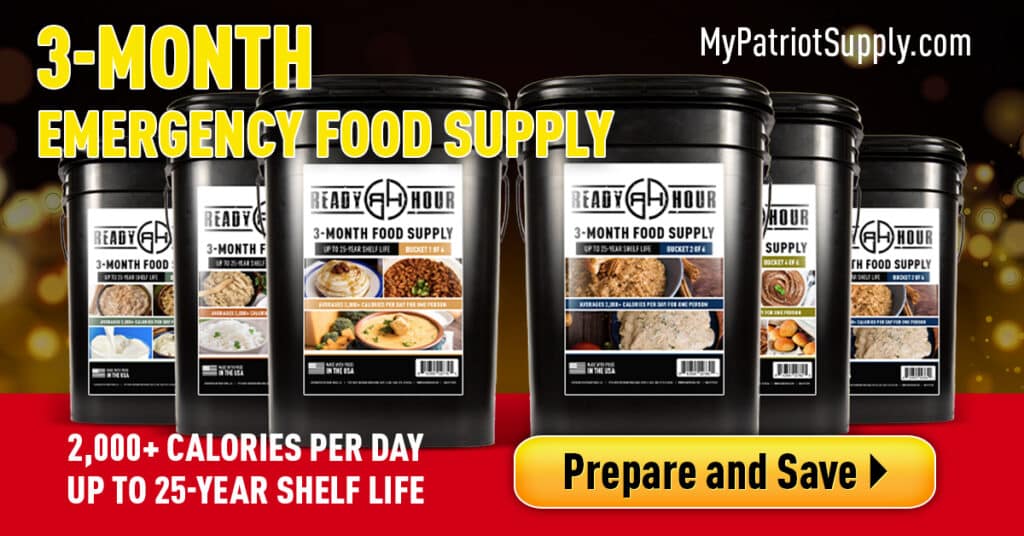In times of disaster, it is essential to have an emergency food supply on hand. An emergency food supply is a collection of non-perishable food items that can sustain you and your family in the event of a prolonged power outage, natural disaster, or other emergency situation. In this article, we will discuss the definition of an essential emergency food supply and provide information on how to build and maintain one.
Types of Emergency Food
There are several types of emergency food to consider when building your supply, including canned goods, dehydrated foods, and freeze-dried meals.
A. Canned goods
Canned goods are among the most common types of emergency food. They are an excellent option because they have a long shelf life, are relatively inexpensive, and require no cooking. Canned goods come in a variety of options, including fruits, vegetables, meats, and soups.
1. Advantages of canned goods
Canned goods are easy to store, require no refrigeration, and have a long shelf life. They are also readily available at most grocery stores and are relatively inexpensive.
2. Disadvantages of canned goods
Canned goods can be heavy and bulky, making them challenging to transport in the event of an evacuation. They are also high in sodium and may not provide the variety of nutrients needed for a balanced diet.
B. Dehydrated foods
Dehydrated foods are another popular option for an emergency food supply. They are lightweight, compact, and have a long shelf life. Dehydrated foods include fruits, vegetables, and meats.
1. Advantages of dehydrated foods
Dehydrated foods are lightweight, compact, and easy to store. They are also rich in nutrients and can be rehydrated quickly with water.
2. Disadvantages of dehydrated foods
Dehydrated foods can be expensive, and they require water for rehydration. They also have a limited shelf life once opened.
C. Freeze-dried meals
Freeze-dried meals are another popular option for emergency food supplies. They are lightweight, compact, and have a long shelf life. Freeze-dried meals include complete meals with a variety of entrées, sides, and snacks.
1. Advantages of freeze-dried meals
Freeze-dried meals are lightweight, compact, and easy to store. They are also easy to prepare, requiring only water to rehydrate.
2. Disadvantages of freeze-dried meals
Freeze-dried meals can be expensive, and they may not offer the variety of nutrients needed for a balanced diet.
D. Comparison of the different types of emergency food
When choosing the type of emergency food to include in your supply, consider factors such as shelf life, nutritional value, and ease of preparation. Each type of emergency food has its advantages and disadvantages, so it is essential to choose the right type for your needs.
Building an Emergency Food Supply
Building an emergency food supply involves determining how much food to store, choosing the right types of food, and storing the food properly.
A. Determining how much food to store
When determining how much food to store, consider factors such as the size of your family, the length of time you want to prepare for, and your budget.
1. Considerations when determining food storage
Consider how much food your family consumes on a daily basis, how long you want to prepare for, and any special dietary needs.
2. Calculation of food storage requirements
A good rule of thumb is to store at least a three-day supply of non-perishable food for each person in your household. For a family of four, this would equate to 36 meals.
B. Choosing the right types of food
When choosing the right types of food, consider factors such as nutritional value, ease of preparation, and shelf life.
1. Criteria to consider when selecting food
Consider the nutritional value of the food, the ease of preparation, and the shelf life of the food.
2. Examples of essential foods to include in an emergency food supply
Some essential foods to include in an emergency food supply include canned fruits and vegetables, canned meats and fish, whole grains, and nuts and seeds.
C. Storing the food properly
When storing emergency food, consider the location, shelf life, and rotation of the food.
1. Storage location considerations
Store emergency food in a location that is cool, dry, and dark. Avoid areas that are subject to temperature fluctuations and moisture.
2. Shelf life of stored food
Most emergency food has a shelf life of several years. However, it is essential to check the expiration dates and rotate the food regularly.
3. Rotation of stored food
Rotate stored food regularly by using the oldest items first and replacing them with fresh items.
Essential Nutrients to Include in Your Emergency Food Supply
In an emergency situation, it is essential to have an adequate supply of essential nutrients. These include protein, carbohydrates, fats, vitamins, and minerals.
A. Importance of essential nutrients in an emergency food supply
Essential nutrients are vital for maintaining good health and preventing malnutrition in an emergency situation.
B. Examples of essential nutrients
Examples of essential nutrients include protein, carbohydrates, fats, vitamins, and minerals.
1. Protein
Protein is essential for maintaining and repairing muscles, organs, and tissues.
2. Carbohydrates
Carbohydrates provide the body with energy.
3. Fats
Fats provide the body with energy and are essential for the absorption of certain vitamins.
4. Vitamins and minerals
Vitamins and minerals are essential for maintaining good health and preventing disease.
C. Foods that provide essential nutrients
Include foods in your emergency food supply that are rich in essential nutrients such as canned meats and fish, canned fruits and vegetables, whole grains, and nuts and seeds.
Building an Emergency Food Supply: A Personal Account
As a resident of a coastal city, I've experienced firsthand the destruction caused by natural disasters. Hurricane Katrina taught me the importance of being prepared for the worst. Consequently, I have built a robust emergency food supply over the years. When Hurricane Harvey hit, I was grateful that I had built my emergency food supply the right way. Here are some lessons I learned:
Determining how much food to store: I calculated the number of calories my family of four would require for a week, which came to around 56,000 calories. Given that, I bought enough food to meet the calorie intake requirements.
Choosing the right types of food: I recommend choosing foods that you would typically eat and enjoy. I included canned fruits, vegetables, and meats, as well as dehydrated fruits, nuts, and seeds, and freeze-dried meals. In addition to essential nutrients, I also included comfort foods and snacks.
Storing the food properly: I stored my emergency food in a cool, dry, and dark area in my basement. I also made sure to rotate the food according to its expiration date.
Water supply considerations: I bought water in bulk and also invested in a water filtration system.
Maintaining your emergency food supply: Regularly inventory checks helped me keep track of the food supplies I had and what I needed to replace.
Having an emergency food supply gave me peace of mind, and I recommend it to anyone living in an area prone to natural disasters.
How to Use Your Emergency Food Supply
Using your emergency food supply involves preparing and cooking tools, rationing your supply, and considering your water supply.
A. Preparation and cooking tools required for an emergency food supply
Ensure you have the necessary preparation and cooking tools, such as a can opener, camping stove, and pot for boiling water.
1. Can opener
A manual can opener is essential for opening canned goods.
2. Camping stove
A camping stove is a portable and efficient way to cook emergency food.
3. Pot for boiling water
A pot for boiling water is essential for preparing dehydrated and freeze-dried meals.
B. Rationing your supply
Ration your emergency food supply to ensure you have enough to last. Determine your daily food intake requirements and consider techniques for stretching your supply.
1. Determining daily food intake requirements
Calculate how much food you need per person per day. A typical adult needs about 2,000 calories per day.
2. Techniques for stretching your supply
Consider techniques such as combining food items, making soups or stews, and supplementing with fresh foods if available.
C. Water supply considerations
Water is essential in an emergency situation. Consider the importance of water, water storage options, and water purification techniques.
1. Importance of water in an emergency
Water is essential for survival. Store at least one gallon of water per person per day.
2. Water storage options
Store water in clean, food-grade containers in a cool, dry, and dark location.
3. Water purification techniques
If you run out of stored water, consider water purification techniques such as boiling, filtering, or using water purification tablets.
Maintaining Your Emergency Food Supply
| Food Item | Recommended Quantity Per Person | Shelf Life |
|---|---|---|
| Canned fruits and vegetables | 14 cans | 2-5 years |
| Canned meats and fish | 14 cans | 2-5 years |
| Whole grains (rice, quinoa, oats, etc.) | 5 pounds | 8-10 years |
| Pasta | 5 pounds | 8-10 years |
| Dried beans | 3 pounds | 8-10 years |
| Nuts and seeds | 1 pound | 6-12 months |
| Peanut butter | 2 jars | 1-2 years |
| Crackers | 2 boxes | 6-9 months |
| Granola bars | 12 bars | 6-9 months |
| Powdered milk | 1 box | 2-10 years |
| Sugar | 4 pounds | Indefinite |
| Salt | 1 pound | Indefinite |
When building your emergency food supply, it is important to consider the recommended quantity of each food item per person and its shelf life. The table above provides a general guideline for recommended quantities and shelf life of essential emergency food items. However, it is important to note that these recommendations may vary depending on the size of your family, dietary needs, and personal preferences.
It is also important to include foods that provide essential nutrients, such as protein, carbohydrates, fats, vitamins, and minerals, as discussed in section IV. Additionally, consider storing foods that are easy to prepare and require minimal cooking, such as canned goods, dehydrated foods, and freeze-dried meals.
Remember to regularly check the inventory of your emergency food supply, properly store the food items in a cool, dry, and dark location, rotate the food items regularly, and replenish the supply when necessary to ensure that you and your family are prepared for any emergency situation.
Maintaining your emergency food supply involves regular inventory checks, proper storage, rotation, and replenishing when necessary.
A. Regular inventory checks required for maintaining an emergency food supply
Check your emergency food supply regularly to ensure it is still viable and has not expired.
B. Proper storage considerations for emergency food supplies
Store emergency food in a location that is cool, dry, and dark, and avoid areas that are subject to temperature fluctuations and moisture.
C. Rotation and expiration date considerations
Rotate your emergency food supply regularly, using the oldest items first, and replacing them with fresh items.
D. Replenishing the supply when necessary
Replenish your emergency food supply when necessary to ensure you always have enough to last.
Conclusion
In conclusion, an emergency food supply is essential for disaster preparedness. When building and maintaining an emergency food supply, consider factors such as the types of food, essential nutrients, and water supply. Ensure you have the necessary preparation and cooking tools, ration your supply, and maintain your supply through regular inventory checks, proper storage, rotation, and replenishment. By following these guidelines, you can be confident that you and your family will have the necessary food and supplies to weather any emergency situation.
The author of this guide is an experienced survivalist who has spent years preparing for emergencies and natural disasters. With a background in wilderness survival and outdoor education, they have a thorough understanding of the importance of having a well-stocked emergency food supply. Additionally, the author has completed courses on nutrition and food science, allowing them to provide insights into the specific nutrients that should be included in an emergency food supply.
Their knowledge is backed by research from reputable sources, such as the American Red Cross and the Centers for Disease Control and Prevention. The author has also conducted their own experiments and trials with various types of emergency food, providing personal anecdotes and insights into the advantages and disadvantages of each.
With a passion for educating others on emergency preparedness, the author has written several articles and guides on the topic. They believe that everyone should have access to the knowledge and resources necessary to be prepared for any situation, and they hope that this guide will help readers feel more confident and prepared in the face of an emergency.




